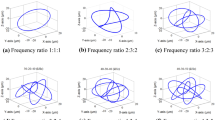Abstract
High quality of machined surfaces is an important requirement in production industries. Therefore, different methods such as ultrasonic vibrations are implemented to improve this parameter. In this study, it is tried to specify some of effective parameters on surface improvement in ultrasonic-assisted turning. Accordingly, a series of experiments in the way of conventional and vibratory turning are conducted where surface roughness and surface topography are evaluated as main objectives of this work. Furthermore, analysis of tool wear and radial displacement of tool and workpiece are carried out for explanation of surface enhancement in vibratory turning. As a result, it is shown that generated typical peaks and valleys in conventional turning are flattened and reduced in vibratory turning which is explained by existence of lower radial force.
Similar content being viewed by others
References
Amini S, Abbaszadeh S, Lotfi M (2017) Measuring wear-resistance of AISI 1.7225 steel under various heat treatments: Hydraulic spool valve. Measurement 98:179–185
Waikar RA, Guo YB (2008) A comprehensive characterization of 3D surface topography induced by hard turning versus grinding. J Mater Process Technol 197(1):189–199
Elbah M, Yallese MA, Aouici H, Mabrouki T, Rigal JF (2013) Comparative assessment of wiper and conventional ceramic tools on surface roughness in hard turning AISI 4140 steel. Measurement 46(9):3041–3056
Chen T, Li S, Han B, Liu G (2014) Study on cutting force and surface micro-topography of hard turning of GCr15 steel. Int J Adv Manuf Technol 72(9–12):1639–1645
Grzesik W, Wanat T (2006) Surface finish generated in hard turning of quenched alloy steel parts using conventional and wiper ceramic inserts. Int J Mach Tools Manuf 46(15):1988–1995
Leppert T (2011) Effect of cooling and lubrication conditions on surface topography and turning process of C45 steel. Int J Mach Tools Manuf 51(2):120–126
Khellaf A, Aouici H, Smaiah S, Boutabba S, Yallese MA, Elbah M (2016) Comparative assessment of two ceramic cutting tools on surface roughness in hard turning of AISI H11 steel: including 2D and 3D surface topography. Int J Adv Manuf Technol:1–22
Brehl DE, Dow TA (2008) Review of vibration-assisted machining. Precis Eng 32(3):153–172
Amini S, Lotfi M, Paktinat H, Kazemiyoun M (2017) Characterization of vibratory turning in cutting zone using a pneumatic quick-stop device. Engineering Science and Technology, an International Journal
Patil S, Joshi S, Tewari A, Joshi SS (2014) Modelling and simulation of effect of ultrasonic vibrations on machining of Ti6Al4V. Ultrasonics 54(2):694–705
Amini S, Mohagheghian N (2014) Vibratory rotary turning process of Al 7075 workpiece. Mater Manuf Process 29(3):344–349
Zhang X, Liu K, Kumar AS, Rahman M (2014) A study of the diamond tool wear suppression mechanism in vibration-assisted machining of steel. J Mater Process Technol 214(2):496–506
Maroju NK, Krishna PV, Jin X (2017) Assessment of high and low frequency vibration assisted turning with material hardness. Int J Mach Mach Mater 19(2):110–135
Sharma V, Pandey PM (2016) Recent advances in ultrasonic assisted turning: A step towards sustainability. Cogent Engineering 3(1):1222776
Zou, P., Xu, Y., He, Y., Chen, M., & Wu, H. (2015). Experimental investigation of ultrasonic vibration assisted turning of 304 austenitic stainless steel. Shock and Vibration, 2015
Nouri, H., Farahnakian, M., & Elhami, S. (2016). Experimental study on the wettability of microtextured surfaces generated by the ultrasonic-assisted face turning. Proceedings of the Institution of Mechanical Engineers, Part J: Journal of Engineering Tribology, 1350650116672144
Sajjady SA, Abadi HNH, Amini S, Nosouhi R (2016) Analytical and experimental study of topography of surface texture in ultrasonic vibration assisted turning. Mater Des 93:311–323
Kurniawan R, Kiswanto G, Ko TJ (2016) Micro-dimple pattern process and orthogonal cutting force analysis of elliptical vibration texturing. Int J Mach Tools Manuf 106:127–140
Amini S, Aghaei M, Lotfi M, Hakimi E (2017) Analysis of linear vibration in rotary turning of AISI 4140 steel. Int J Adv Manuf Technol:1–10
Amini S, Shamoto E, Suzuki N, Nategh MJ (2010) FE analysis of one-directional and elliptical vibration cutting processes. Int J Autom Technol 4(3):1–7
D’Addona DM, Raykar SJ (2016) Analysis of surface roughness in hard turning using wiper insert geometry. Procedia CIRP 41:841–846
Lotfi M, Farid AA, Soleimanimehr H (2016) A new hybrid model based on the radius ratio for prediction of effective cutting limit of chip breakers. Proc Inst Mech Eng B J Eng Manuf 230(8):1417–1427
Lotfi, M., & Amini, S. (2016). Effect of ultrasonic vibration on frictional behavior of tool–chip interface: finite element analysis and experimental study. Proceedings of the Institution of Mechanical Engineers, Part B: Journal of Engineering Manufacture, 0954405416666895
Lotfi, M., & Amini, S. (2017). FE simulation of linear and elliptical ultrasonic vibrations in turning of Inconel 718. Proceedings of the Institution of Mechanical Engineers, Part E: Journal of Process Mechanical Engineering, 0954408917715533
Lotfi M, Amini S (2017) Experimental and numerical study of ultrasonically-assisted drilling. Ultrasonics 75:185–193
Altintas Y (2012) Manufacturing automation: metal cutting mechanics, machine tool vibrations, and CNC design. Cambridge university press
Zhang J, Liu Z, Du J (2016) Prediction of cutting temperature distributions on rake face of coated cutting tools. Int J Adv Manuf Technol:1–9
Author information
Authors and Affiliations
Corresponding author
Rights and permissions
About this article
Cite this article
Lotfi, M., Amini, S. & Aghaei, M. 3D analysis of surface topography in vibratory turning. Int J Adv Manuf Technol 95, 197–204 (2018). https://doi.org/10.1007/s00170-017-1183-3
Received:
Accepted:
Published:
Issue Date:
DOI: https://doi.org/10.1007/s00170-017-1183-3



